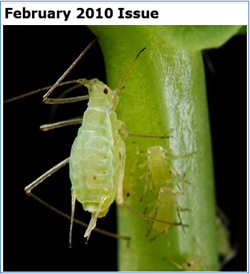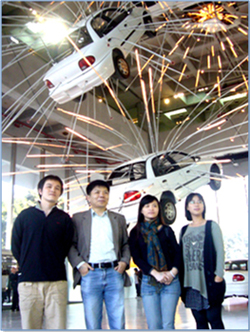

 |
||
|
::: New Milestone in Molecular Agriculture: |
||
 Figure 1. Photo provided by Department of Entomology Professor Chun-Che Chang's Laboratory appeared on the cover of the recent issue of PLoS Biology。Photo by: Shih-Wei Wu, Insect provided by: Gee-Way Lin  Figure 2. NTU Developmental Genetics Research team members: (from left to right) Ting-Yu Huang, Professor Chun-Che Chang, Hsiao-Ling Lu, Gee-Way Lin An analysis of the whole genome sequence of the pea aphid was published as a feature article in the latest issue of PLoS Biology, a prestigious journal in the field of life sciences. The Laboratory of Dr. Chun-che Chang, a research unit in the Department of Entomology at the Bio-Agricultural College of National Taiwan University (NTU), participated in this important publication and the feature image on the journal's cover page was just provided by the Chang Lab. Chang, a developmental geneticist and an associate professor affiliated with NTU, and his Ph.D. student Hsiao-ling Lu have been members of the International Aphid Genomics Consortium (IAGC) since August 2008, and since then they have been actively involved in the genome analysis. Sequencing of the aphid genome was performed by the Human Genome Sequence Center at the Baylor College of Medicine. In the past few years, project leaders from the U.S., France, Japan, and scientists from more than ten nations worked together to decode the pea aphid genome. Chang, who was designated a leader of the germline annotation group in the genome paper, and Lu analyzed potential genes involved in germline determination as well as those in early development. "The annotation can serve as an important molecular reference for further studies", Chang said. Although the genome paper in PLoS Biology, namely the main paper, was 24 pages long, it could not include all of the analytical data. Members of the IAGC thus submitted other manuscripts to Insect Molecular Biology (IMB), a leading journal in the field of Entomology. After a peer-review process, the accepted manuscripts were published in a special issue of IMB that focused on the aphid genome in parallel with the publication of the main paper in PLoS Biology. In this special issue, Chang and his Ph.D. student Ting-Yu Huang, together with collaborators from Japan and the U.S., delivered an important paper regarding the anterior development in embryos of the pea aphid. They found that the "hunchback" gene, whose name reminds us of Victor Hugo's novel The Hunchback of Notre Dame, played different roles from those played by the same gene in other insects. In the same issue Chang, Lu and Gee-way Lin (Ph.D. student of Chang) are coauthors of another paper describing comprehensive studies of developmental genes—a project led by Dr. Shuji Shigenobu of the National Institute of Basic Biology in Japan. In addition to papers in scientific journals, news about the analysis and sequencing of the aphid genome was also soon reported in the media of U.K., U.S., Japan, Spain, New Zealand, and other countries. For an organism, the genome sequence is described as "the book of life" or "the instruction book of life". Hence decoding the aphid genome can reveal the secrets of aphids' complicated life cycles and can help scientists to develop strategies for reducing the aphid population. Aphids are hemipteran insects and host-plant specialists. They suck sap from plants with needle-like mouthparts and can transmit viruses from one plant to another as they feed. The life cycle of aphids includes sexual and asexual phases which are regulated by photoperiods. Under long-day period (16 hours light/8 hours dark), they spread rampantly through parthenogenetic and viviparous reproduction. "When the yellow pollen aphids (Indomegoura indica) reproduce vigorously at the farm of the NTU campus, the host plant tiger lilies are covered all over with the aphids. Looking from afar one would think that the tiger lilies were in full bloom", said Chang. To date, molecular mechanisms for the conversion between the sexual and asexual generations of the aphids remain unknown. Optimistically, because the whole genome sequences of the pea aphid are now accessible, utilization of the functional-genomics tools enables scientists to study molecular mechanisms, at large scale, for the conversion of reproduction modes, the vectoring of virus, and the metabolic interactions between aphids and symbionts. "If scientists can find the "switch sequences" that trigger the conversion between sexual and asexual phases, holding aphids within the sexual life cycle might be possible. Moreover, because the sexual generation, which takes 3 or 4 months, is much longer than the asexual generation that normally takes about only two weeks, the size of the aphid population could be largely reduced", Chang added. In the aphid genome project the pea aphid Acyrthosiphon pisum was selected as the sequence target among nearly 5000 species of aphids because of its abundant molecular references. "The size of the pea aphid is comparatively big so that it becomes an advantage for observation and manipulation", Chang said. A haploid genome of the pea aphid, with a total length of 460 million base pairs, is composed of 3 autosomes plus one X chromosome. Given that aphids are the first sequenced hemimetabolous insects, the whole genome sequence of aphids thus can serve as an outgroup when aligned with published genomes of highly differentiated insects such as flies, beetles and silk worms, all of which are holometabolous. Because of the ancient nature of the aphid genome, it can shed light on the evolution of insect genomes. According to Chang, IAGC members discovered that gene duplication occurred to about 2000 gene families in the pea aphid. For example, the germline gene "vasa" has four copies – unlikd any other published genome. As described in the main paper, perhaps the extraordinarily high frequency of gene duplication simply reflects aphids' complicated life history, "but dissecting the function of duplicated genes still remains a big challenge", said Chang. Chang and his PhD students thank the support of the National Science Council and the Bureau of Animal and Plant Health Inspection and Quarantine of the Council of Agriculture. Also they are very grateful to Dr. Yue-Ie Hsing and her lab members in the Academia Sinica, for sharing their experience in analyzing the rice genome. As Chang said, it was very helpful to have the help from experienced genome experts particularly when dealing with huge genome sequences of the pea aphid at the very beginning. "Of course, that the members of the IAGC shared analytical results unselfishly and effectively is also a key to the success of the aphid genome project", Chang added. From 2002 until the present, Chang had three papers published as cover stories or feature articles (2002, grasshoppers; 2006 and 2010, aphids). Coincidentally, all the protagonists on the covers/front pages are regarded as "non-model organisms". As Chang said, "all model organisms were derived from non-model organisms". "Although few tools are available for studying non-model organisms, seeing unexpected findings and exploring the biological significance behind them leads to a lot of fun and sense of achievement. In effect, most insect pests that cause severe damage to crops are still at the status of non-model organisms", Chang explained. He believes that the successful case of decoding the aphid genome can become a good example to cracking genomes of other insects of agricultural importance. |
||
No. 1, Sec. 4, Roosevelt Road, Taipei, 10617 Taiwan(R.O.C.)
Phone: +886-2-3366-3366 Fax: +886-2-2362-7651